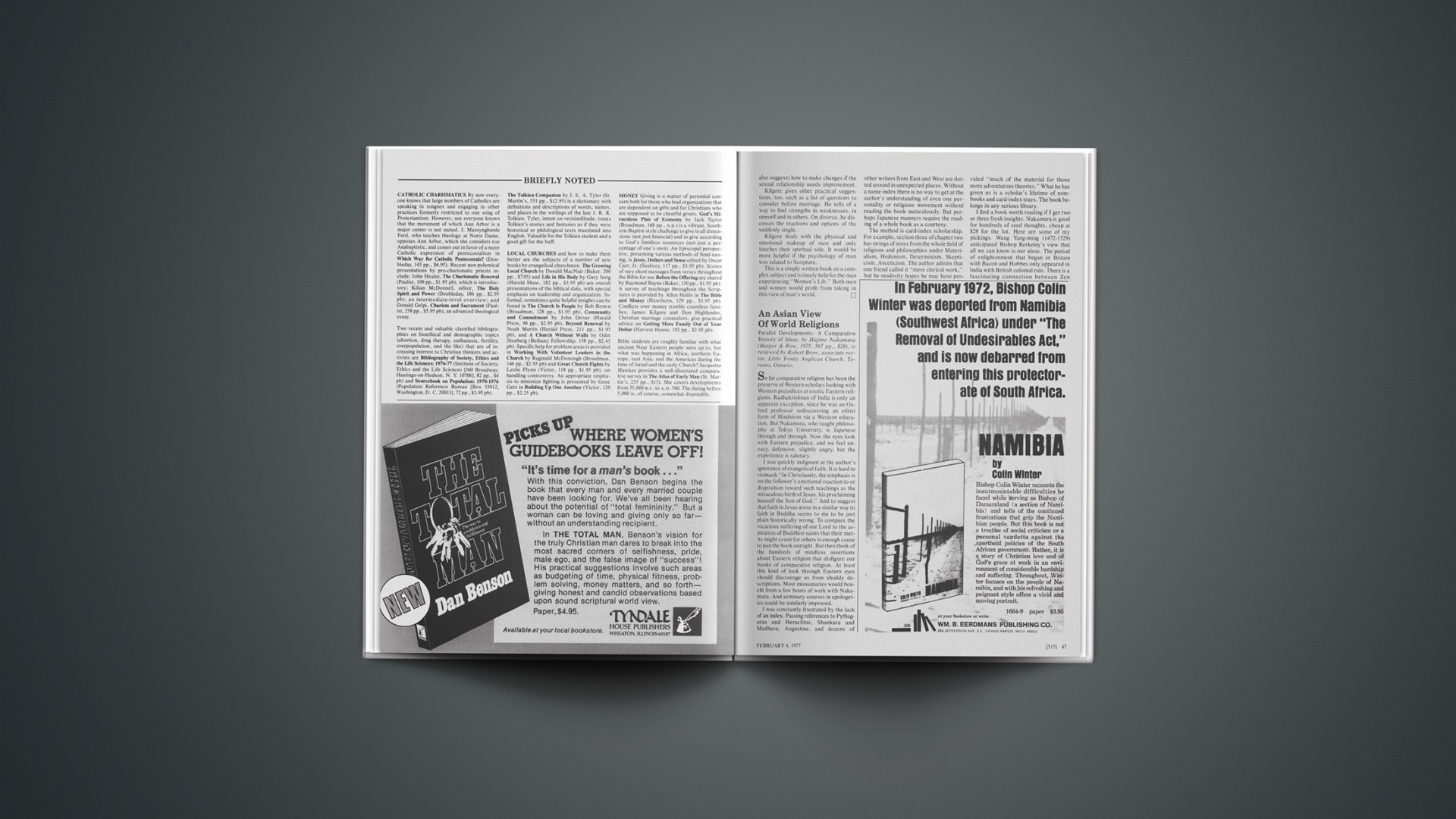Dooyeweerd Made Digestible
Contours of a Christian Philosophy: An Introduction to Herman Dooyeweerd’s Thought, by L. Kalsbeek (Wedge Publishing [229 College St., Toronto, Ont. M5T 1R4], 1975, 360 pp., $12.50, is reviewed by Robert Countess, first battalion chaplain, Army Engineer Center Brigade, Fort Belvoir, Virginia.
For those who have wanted a clear and concise introduction to the philosophy of Dooyeweerd, the long wait is over. Who is there whose initial response was not dismay when he was introduced to the four ponderous volumes that make up Dooyeweerd’s magnum opus, A New Critique of Theoretical Thought? Those who ventured to open a volume and read a sentence or paragraph (is there a difference in Dooyeweerd?) were likely to sink back in despair over their inability to comprehend what appeared to be the English language. The English translation from the Dutch has been criticized by numerous bilinguals as being inadequate and at times misleading.
Perhaps one is acquainted with this Amsterdamer not through his own but through Rousas J. Rushdoony’s works. But it could be that one’s acquaintance stems from the virulent critique of Robert Morey’s The Dooyeweerdian Concept of the Word of God, in which Dooyeweerd and company are pictured as heretic, apostate, humanist, or worse. If so, then one would probably not care that a clear introduction to Dooyeweerd is now available.
But those who believe with Dooyeweerd and Calvin that “the true knowledge of ourselves is dependent on the true knowledge of God” should care. Those who hold that “What is man?” is the central question at the beginning and conclusion of philosophical reflection should care. Those who believe that man can regain true self-knowledge “only by surrendering to Jesus Christ, the word made flesh, the Redeemer who, by his word and Spirit, converts our inner being so that our heart again is directed to God” should care. Those who believe that “sin is the opposite of service; it is the false illusion that the human selfhood can be independent and self-sufficient, like God himself” should care.
Kalsbeek’s book is intended not for philosophers but for “persons with an interest in philosophy who discover that existing introductions and the extensive publications of Herman Dooyeweerd … are initially too difficult.” After a most helpful opening biographical sketch by Bernard Zylstra, Kalsbeek begins his first of thirty-eight chapters with the question “What is philosophy?” An answer is that “to philosophize is to discern the structure of creation and to describe systematically, i.e., in logical order, what is subject to that structure.”
Then he launches into one of his many excellent illustrations from everyday life—this one, the report of an event in the newspaper, which demonstrates the many facets of the event. With this he is off running and philosophizing Christianly.
It is, to be sure, Christian philosophizing. Dooyeweerd has emblazoned over the door of his classroom “Know thyself,” and he believes with Calvin that only the believer in Jesus Christ can have true self-knowledge. For Dooyeweerd, the antithesis between those who worship and serve the Creator and those who worship and serve creation (or one of its aspects) is fundamental to philosophical activity. Even so, “the presence of a regenerate heart is no guarantee that a person will not err in his thinking and acting; neither can we conclude from a man’s error of thought or action that his heart is unregenerate.”
Kalsbeek’s chapters are short, averaging about seven pages, and he uses only a minimum of technical terms and foreign words. Some of the chapter topics may whet one’s interest: “Out of the heart are the issues of life,” immanence and transcendence, Archimedean point and arche, ground motives of Western thought, sphere sovereignty, isms, what is time?, the problem of knowledge, structures of human society (the family, marriage, state, church, voluntary associations), and philosophical anthropology.
Footnotes are relegated to an appendix. The bibliography contains more than 500 entries, which are divided into of, about, friends, and foes. Most readers will appreciate the nine-page glossary of terms, followed by indexes of persons and subjects. (I suggest that every philosophy and theology book be required by law to have a glossary of terms used in it!)
Serious Christians would do well to work their way through this book—and it will take work. Kalsbeek will be found to be an invaluable guide. He styles himself as spiritually akin to, rather than adhering to, Dooyeweerd’s philosophy. Occasionally he is the sympathetic critic. Always he is a gentleman.
Help For Males
Being a Man in a Woman’s World, by James Kilgore (Harvest House, 1976, 146 pp., $2.95 pb), is reviewed by Elaine Mathiasen, Boise, Idaho.
Kilgore wants to help men feel secure in their masculinity and experience satisfying relationships with women. His philosophy emphasizes that a man must examine his thoughts, feelings, and behavior and then totally accept himself. This frees him to accept other people and to give himself to others; he will no longer fear exposure in close relationships. This philosophy comes from Jesus’ admonition to “love your neighbor as yourself” and applies to men and women.
Kilgore discusses several characteristics that would help any man make his home or office a happier and more efficient place. These include assertiveness, awareness, leadership, enthusiasm, and positiveness.
In a chapter on sexual relationships, the emphasis is placed on the need for a man first to share his mind with a woman before giving himself physically. Men may be astonished that Kilgore advises them to reveal their inner selves to a woman for a closer physical relationship; women will simply applaud him. Kilgore also discusses the importance of thinking highly of a woman, rather than being critical. This principle applies to all relationships: what we expect from someone is usually what we receive. This chapter also suggests how to make changes if the sexual relationship needs improvement.
Kilgore gives other practical suggestions, too, such as a list of questions to consider before marriage. He tells of a way to find strengths in weaknesses, in oneself and in others. On divorce, he discusses the reactions and options of the suddenly single.
Kilgore deals with the physical and emotional makeup of men and only touches their spiritual side. It would be more helpful if the psychology of man was related to Scripture.
This is a simply written book on a complex subject and is timely help for the man experiencing “Women’s Lib.” Both men and women would profit from taking in this view of man’s world.
An Asian View Of World Religions
Parallel Developments: A Comparative History of Ideas, by Hajime Nakamura (Harper & Row, 1975, 567 pp., $28), is reviewed by Robert Brow, associate rector, Little Trinity Anglican Church, Toronto, Ontario.
So far comparative religion has been the preserve of Western scholars looking with Western prejudices at exotic Eastern religions. Radhakrishnan of India is only an apparent exception, since he was an Oxford professor rediscovering an elitist form of Hinduism via a Western education. But Nakamura, who taught philosophy at Tokyo University, is Japanese through and through. Now the eyes look with Eastern prejudice, and we feel uneasy, defensive, slightly angry, but the experience is salutary.
I was quickly indignant at the author’s ignorance of evangelical faith. It is hard to stomach “In Christianity, the emphasis is on the follower’s emotional reaction to or disposition toward such teachings as the miraculous birth of Jesus, his proclaiming himself the Son of God.” And to suggest that faith in Jesus arose in a similar way to faith in Buddha seems to me to be just plain historically wrong. To compare the vicarious suffering of our Lord to the aspiration of Buddhist saints that their merits might count for others is enough cause to pan the book outright. But then think of the hundreds of mindless assertions about Eastern religion that disfigure our books of comparative religion. At least this kind of look through Eastern eyes should discourage us from shoddy descriptions. Most missionaries would benefit from a few hours of work with Nakamura. And seminary courses in apologetics could be similarly improved.
I was constantly frustrated by the lack of an index. Passing references to Pythagoras and Heraclitus, Shankara and Madhava, Augustine, and dozens of other writers from East and West are dotted around in unexpected places. Without a name index there is no way to get at the author’s understanding of even one personality or religious movement without reading the book meticulously. But perhaps Japanese manners require the reading of a whole book as a courtesy.
The method is card-index scholarship. For example, section three of chapter two has strings of notes from the whole field of religions and philosophies under Materialism, Hedonism, Determinism, Skepticism, Asceticism. The author admits that one friend called it “mere clerical work,” but he modestly hopes he may have provided “much of the material for those more adventurous theories.” What he has given us is a scholar’s lifetime of notebooks and card-index trays. The book belongs in any serious library.
I find a book worth reading if I get two or three fresh insights. Nakamura is good for hundreds of seed thoughts, cheap at $28 for the lot. Here are some of my pickings. Wang Yang-ming (1472–1529) anticipated Bishop Berkeley’s view that all we can know is our ideas. The period of enlightenment that began in Britain with Bacon and Hobbes only appeared in India with British colonial rule. There is a fascinating connection between Zen monasticism and the Benedictines. Before Tao-hsin (586–651) Buddhist monks had been mendicants, but from that time Zen monks valued manual labor. A great unknown body of Japanese philosophical works written in classical Chinese and archaic Japanese awaits the study of Western scholars. No Eastern philosophers ever stressed the Western view of evolution in the sense “that something coming is superior to the former thing it replaced.” We assumed that evolution means progress: perhaps we are being forced back to the Hindu view that evolution is a terrifying round of misery to be escaped. The koans of Zen Buddhism and the Tantric sexual rites of Hinduism had no parallel in any other religion. Three hundred years before Luther the Buddhist Shinran turned from asceticism to grace, used the vernacular of the people, and stressed the sermon based on “the redemption which follows grace.”
Professor Nakamura rightly insists that there is no dividing line between religion and the great philosophies. I would add that you cannot even divide off the ideologies if they demand a total commitment from us. How could you divide Anarchism from Taoism, Plotinus from Hindu Vedanta, Zen from Existentialism? That being the case, Nakamura shows us the huge task facing serious evangelical scholarship. We can no longer be patronizing investigators of distant religions. We live in a pluralistic world, in many places on the defensive, and the battle of religions and ideologies rages all around us.
It is easy for us to see that Nakamura fails to be truly objective. His viewpoint seems to be rooted in a kind of Japanese logical positivism. But how can we be objective in the study of comparative religions and ideologies and yet committed to an evangelical faith? At least we could reject the temptation to talk about another religion until we have really grasped and felt its inner logic. And that applies as well to Moon religion, or Krishna Consciousness, Zen, or the queerest of Christian sects. There has to be an honest description, which I take to mean a description totally acceptable to a well taught devotee of the religion in question. If we do our job well, we will produce a natural history of the religions and ideologies that men live by, what makes them tick, their supreme pursuit. We then have to believe that if we set the Bible’s own description of Jesus Christ next to all other faiths, the Holy Spirit will do his own work of conversion. Why should the Spirit of truth wish to bless a dishonest comparison? When showing off the pearl of great price, we need never feel that other pearls might benefit by being seen exactly as they are.
The World Of The First Christians
The New Testament Environment, by Eduard Lohse (Abingdon, 1976, 296 pp., $12.95, and $6.95 pb), is reviewed by David E. Aune, professor of religion, Saint Xavier College, Chicago, Illinois.
One of the fundamental assumptions of modern biblical scholarship is that one cannot adequately understand and interpret the Bible without knowing about the various contexts (historical, social, cultural, and religious) within which its component documents were written. While the author (bishop of the Evangelical Church of Hannover, Germany, since 1971 and former professor of New Testament at Göttingen) affirms that the New Testament itself is the single most important source of information regarding its environment, the information presented in this superb introductory text has been gleaned from primary sources roughly contemporary with the rise of Christianity: literature, inscriptions, nonliterary documents (papyri), archaeological data.
The book is a remarkably successful attempt to summarize those environmental features that are of direct relevance for interpreting the New Testament. Lohse frequently correlates this background information with scriptural passages whose meaning is clarified by this additional knowledge. Although he never refers to secondary literature in the text (a five-page bibliography is appended to the book), he clearly has a commanding grasp of the general tendencies and results of modern research in the areas of Judaism and the Graeco-Roman world. The value of this book for classroom use could be enhanced if it were paired with a discriminating collection of source material such as C. K. Barrett’s The New Testament Background: Selected Documents or H. C. Kee’s The Origins of Christianity: Sources and Documents.
Lohse adheres to the traditional format for such introductions to the New Testament world by dividing his book into two parts, “Judaism in the Time of the New Testament” (181 pp.), and “The Hellenistic Roman Environment of the New Testament” (80 pp.). Giving more consideration to Judaism reflects a general tendency in New Testament research during the last twenty years more than the author’s own predilections. Similarly, the much shorter treatment of the Graeco-Roman environment is a sign of the relatively slight use that New Testament scholars have made of the potentially great contribution of classical studies. On this subject the views of two prominent evangelical scholars should be considered: F. F. Bruce, “The New Testament and Classical Studies,” New Testament Studies, 22 (1976), 229–42, and E. A. Judge, “St. Paul and Classical Society,” Jahrbuch für Antike und Christentum, 15 (1972), 19–36.
A number of weaknesses are in evidence: (1) The bibliography, an important feature in such an introductory text, suffers from a number of glaring omissions (e.g., the recent revision of Schürer, Safrai, and Stern’s first volume of Compendia Rerum Iudaicarum ad Novum Testamentum, and Yamauchi’s Pre-Christian Gnosticism). (2) While Lohse’s thirty-nine-page summary of Palestinian political history is superb, the volume lacks an adequate political history of various regions that served as theaters for the expansion of early Christianity (Greek peninsula, Asia Minor, Egypt, Syria). (3) In the author’s forty-nine-page summary of Jewish life and belief, the sometimes distinctive emphases of diaspora Judaism are largely passed over. (4) The section on the Hellenistic Roman environment lacks a treatment of the life and belief of Graeco-Roman peoples. (5) The burgeoning emphases on magic, sorcery, astrology, and demonology in popular belief and life are insufficiently treated. Nevertheless, Lohse has produced the best one-volume survey of the New Testament world.
Briefly Noted
CATHOLIC CHARISMATICS By now everyone knows that large numbers of Catholics are speaking in tongues and engaging in other practices formerly restricted to one wing of Protestantism. However, not everyone knows that the movement of which Ann Arbor is a major center is not united. J. Massyngberde Ford, who teaches theology at Notre Dame, opposes Ann Arbor, which she considers too Anabaptistic, and comes out in favor of a more Catholic expression of pentecostalism in Which Way for Catholic Pentecostals? (Doubleday, 143 pp., $6.95). Recent non-polemical presentations by pro-charismatic priests include: John Healey, The Charismatic Renewal (Paulist, 109 pp., $1.95 pb), which is introductory; Kilian McDonnell, editor, The Holy Spirit and Power (Doubleday, 186 pp., $2.95 pb), an intermediate-level overview; and Donald Gelpi, Charism and Sacrament (Paulist, 258 pp., $5.95 pb), an advanced theological essay.
Two recent and valuable classified bibliographies on bioethical and demographic topics (abortion, drug therapy, euthanasia, fertility, overpopulation, and the like) that are of increasing interest to Christian thinkers and activists are Bibliography of Society, Ethics and the Life Sciences: 1976–77 (Institute of Society, Ethics and the Life Sciences [360 Broadway, Hastings-on-Hudson, N. Y. 10706], 82 pp., $4 pb) and Sourcebook on Population: 1970–1976 (Population Reference Bureau [Box 35012, Washington, D. C. 20013], 72 pp., $3.95 pb).
The Tolkien Companion by J. E. A. Tyler (St. Martin’s, 531 pp., $12.95) is a dictionary with definitions and descriptions of words, names, and places in the writings of the late J. R. R. Tolkien. Tyler, intent on verisimilitude, treats Tolkien’s stories and fantasies as if they were historical or philological texts translated into English. Valuable for the Tolkien student and a good gift for the buff.
LOCAL CHURCHES and how to make them better are the subjects of a number of new books by evangelical churchmen. The Growing Local Church by Donald MacNair (Baker, 200 pp., $7.95) and Life in His Body by Gary Inrig (Harold Shaw, 182 pp., $3.95 pb) are overall presentations of the biblical data, with special emphasis on leadership and organization. Informal, sometimes quite helpful insights can be found in The Church Is People by Bob Brown (Broadman, 128 pp., $1.95 pb), Community and Commitment by John Driver (Herald Press, 94 pp., $2.95 pb), Beyond Renewal by Noah Martin (Herald Press, 211 pp., $1.95 pb), and A Church Without Walls by Odin Stenberg (Bethany Fellowship, 158 pp., $2.45 pb). Specific help for problem areas is provided in Working With Volunteer Leaders in the Church by Reginald McDonough (Broadman, 146 pp., $2.95 pb) and Great Church Fights by Leslie Flynn (Victor, 118 pp., $1.95 pb), on handling controversy. An appropriate emphasis to minimize fighting is presented by Gene Getz in Building Up One Another (Victor, 120 pp., $2.25 pb).
MONEY Giving is a matter of perennial concern both for those who lead organizations that are dependent on gifts and for Christians who are supposed to be cheerful givers. God’s Miraculous Plan of Economy by Jack Taylor (Broadman, 168 pp., n.p.) is a vibrant. Southern-Baptist-style challenge to give in all dimensions (not just financial) and to give according to God’s limitless resources (not just a percentage of one’s own). An Episcopal perspective, presenting various methods of fund-raising, is Jesus, Dollars and Sense edited by Oscar Carr, Jr. (Seabury, 117 pp., $3.95 pb). Scores of very short messages from verses throughout the Bible for use Before the Offering are shared by Raymond Bayne (Baker, 130 pp., $1.95 pb). A survey of teachings throughout the Scriptures is provided by Allen Hollis in The Bible and Money (Hawthorn, 129 pp., $3.95 pb). Conflicts over money trouble countless families. James Kilgore and Don Highlander, Christian marriage counselors, give practical advice on Getting More Family Out of Your Dollar (Harvest House, 192 pp., $2.95 pb).
Bible students are roughly familiar with what ancient Near Eastern people were up to, but what was happening in Africa, northern Europe, east Asia, and the Americas during the time of Israel and the early Church? Jacquetta Hawkes provides a well-illustrated comparative survey in The Atlas of Early Man (St. Martin’s, 255 pp., $15). She covers developments from 35,000 B.C. to A.D. 500. The dating before 5,000 is, of course, somewhat disputable.
TESTIMONIES to the power of God to transform lives are abundant. Recently there has been a tendency toward more honesty about the downs as well as the ups. Recent ones that may be of interest: What I Have Lived By by Charles L. Allen (Revell, 159 pp., $5.95), well-known preacher and author; Joni by Joni Eareckson (Zondervan, 228 pp., $6.95), quadriplegic artist (her mouth guides her pen); God of the Untouchables by Dave Hunt (Revell, 156 pp., $5.95), about Paul Gupta, an Indian Christian leader who is a convert from Hinduism; Surgeon on Safari by Paul Jorden and James Adair (Hawthorn, 173 pp., $6.95), about a surgeon and his large family on short-term mission in Kenya; Success Without Succeeding by Richard LeTourneau (Zondervan, 159 pp., $2.95 pb), son of the widely known construction-machinery tycoon; Out of the Sea by James Leynse (Good News Publishers, 190 pp., $3.50 pb), in which the author intersperses his own childhood recollections with the history of his native Netherlands; A Gift of Love by Gail Magruder (Holman, 160 pp., $6.95), whose husband, Jeb, was imprisoned because of Watergate and now is a leader with Young Life; No More For the Road by Duane Mehl (Augsburg, 159 pp., $3.50 pb), a pastor who overcame alcoholism; The Miracle Goes On by John Peterson (Zondervan, 220 pp., $6.95), autobiography of a widely known composer; Tomorrow You Die by Reona Peterson (Bible Voice, 142 pp., $2.95 pb), about a missionary visit to the most isolated European country, Albania; Scott Free by Scott Ross (Revell, 156 pp., $5.95), an entertainer who found that conversion to Christ seemed to make things worse.










